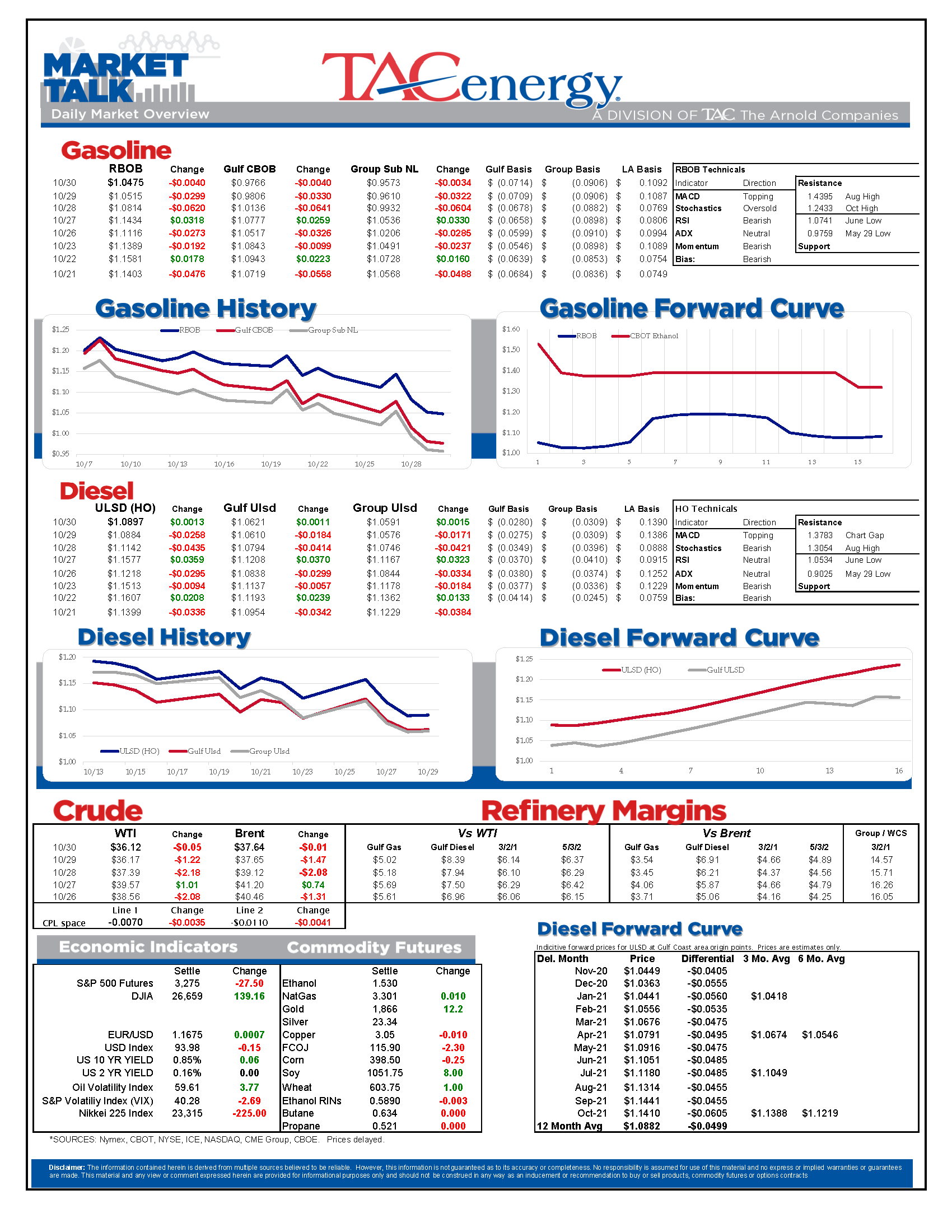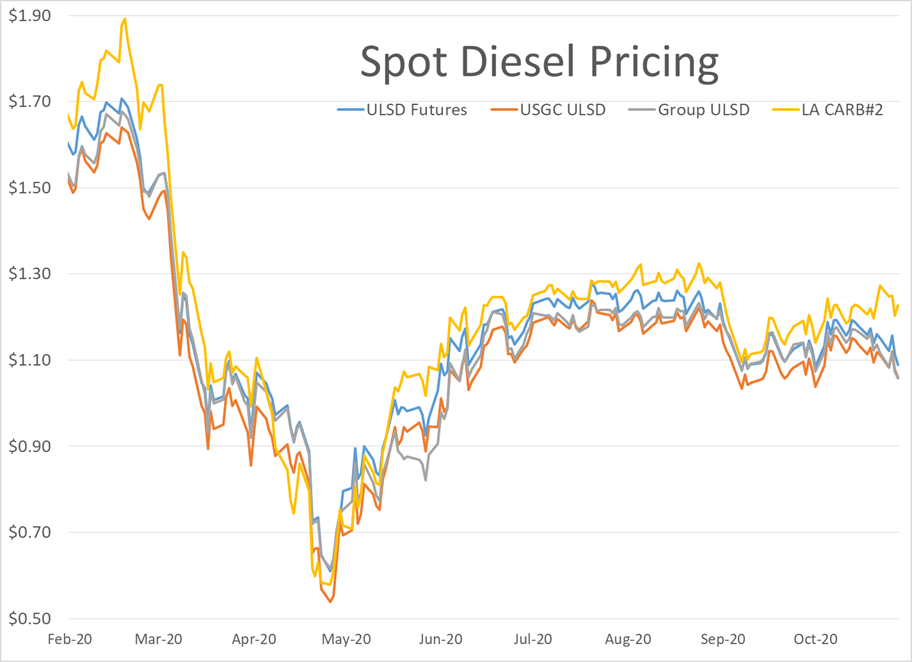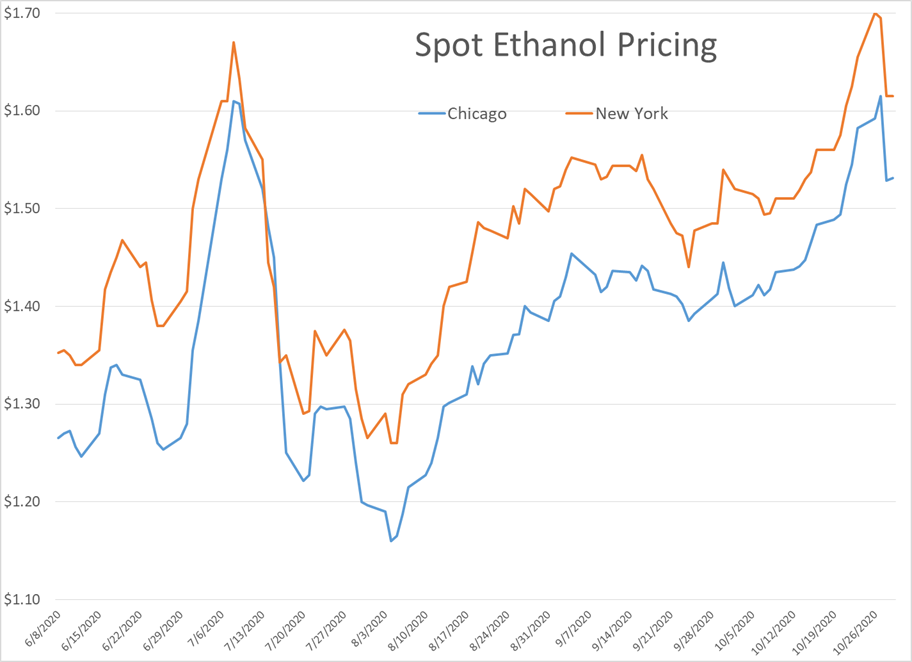Calm Between Storms For Energy Markets

The calm between storms has set in on energy markets to start Friday’s trading with only fractional moves so far, after a week of mostly heavy selling. The dark cloud of rapidly rising COVID counts continues to hang over markets around the globe, while next week’s election is expected to create even more volatility.
November RBOB and HO contracts expire today, so watch the December contracts (RBZ/HOZ) for price direction today. RBOB futures reached their lowest levels since May during Thursday’s selloff, but held support just above the $1 mark, holding off a technical collapse for now. WTI and ULSD finally found a bid just a few ticks above their June lows meaning the sideways pattern is still hanging on by a thread. If the range finally breaks down, it looks like we’ll see another 10-20 cent drop for products in short order.
Gulf Coast gasoline prices joined the Group 3 market in the under $1 club Thursday. Chicago and NYH prices are just about a nickel away, while West Coast values still have more than a dime to fall before reaching that level. Ethanol prices saw their bubble burst as both corn and gasoline prices have plummeted this week. The upward momentum in RIN values also appears to have stalled out temporarily, with the weaker commodity values and the announcement that there will be one less obligated refinery requiring RINs next year managing to push both D4 and D6 prices back down from multi-year highs.
Big Oil earnings reports for Q3 being released this week are shedding more light on the challenging environment that’s forcing more job cuts, even with oil prices trading north of $40 for most of the quarter. Q4 is looking even worse with the drop in prices the past couple of weeks, and demand forecasts continuing to decline. While most OPEC members don’t release earnings reports like public corporations due, it’s fairly easy to extrapolate that they’re facing similar challenges, which makes the need to extend production cuts clear, although the will to do so from some members is less so.
The parade of hurricanes in the Gulf Coast isn’t helping oil producers as several noted in their earnings reports the reduced output and additional costs of having to shut in and restart production (not to mention shuttling employees to and from the rigs) have happened at the worst possible time.
As the Atlantic Coast dries out from the remnants of Hurricane Zeta today, the NHC is already giving a high probability of another named storm forming over the weekend. The disturbance has 80% odds of becoming the next named storm as it moves into the Caribbean over the next five days, but so far the NHC isn’t publishing a potential path for after it develops. This is close to where both hurricanes Delta and Zeta formed, so another hit to the Gulf Coast is still possible even as we move into the last few weeks of the season.
Another one bites the dust: BP announced it would shut Australia’s largest refinery, converting it to an import terminal, as operating the plant was no longer “economically viable." At 150mb/day, the plant is not large by U.S. refining standards, and won’t be missed in the current environment, but is the latest in a long string of rationalizations globally that’s expected to continue as long as demand is weak.
Click here to download a PDF of today's TACenergy Market Talk.
Latest Posts
Gasoline Futures Are Leading The Way Lower This Morning
The Sell-Off Continues In Energy Markets, RBOB Gasoline Futures Are Now Down Nearly 13 Cents In The Past Two Days
Week 15 - US DOE Inventory Recap
Prices To Lease Space On Colonial’s Main Gasoline Line Continue To Rally This Week
Social Media
News & Views
View All
Gasoline Futures Are Leading The Way Lower This Morning
It was a volatile night for markets around the world as Israel reportedly launched a direct strike against Iran. Many global markets, from equities to currencies to commodities saw big swings as traders initially braced for the worst, then reversed course rapidly once Iran indicated that it was not planning to retaliate. Refined products spiked following the initial reports, with ULSD futures up 11 cents and RBOB up 7 at their highest, only to reverse to losses this morning. Equities saw similar moves in reverse overnight as a flight to safety trade soon gave way to a sigh of relief recovery.
Gasoline futures are leading the way lower this morning, adding to the argument that we may have seen the spring peak in prices a week ago, unless some actual disruption pops up in the coming weeks. The longer term up-trend is still intact and sets a near-term target to the downside roughly 9 cents below current values. ULSD meanwhile is just a nickel away from setting new lows for the year, which would open up a technical trap door for prices to slide another 30 cents as we move towards summer.
A Reuters report this morning suggests that the EPA is ready to announce another temporary waiver of smog-prevention rules that will allow E15 sales this summer as political winds continue to prove stronger than any legitimate environmental agenda. RIN prices had stabilized around 45 cents/RIN for D4 and D6 credits this week and are already trading a penny lower following this report.
Delek’s Big Spring refinery reported maintenance on an FCC unit that would require 3 days of work. That facility, along with several others across TX, have had numerous issues ever since the deep freeze events in 2021 and 2024 did widespread damage. Meanwhile, overnight storms across the Midwest caused at least one terminal to be knocked offline in the St. Louis area, but so far no refinery upsets have been reported.
Meanwhile, in Russia: Refiners are apparently installing anti-drone nets to protect their facilities since apparently their sling shots stopped working.
Click here to download a PDF of today's TACenergy Market Talk.

The Sell-Off Continues In Energy Markets, RBOB Gasoline Futures Are Now Down Nearly 13 Cents In The Past Two Days
The sell-off continues in energy markets. RBOB gasoline futures are now down nearly 13 cents in the past two days, and have fallen 16 cents from a week ago, leading to questions about whether or not we’ve seen the seasonal peak in gasoline prices. ULSD futures are also coming under heavy selling pressure, dropping 15 cents so far this week and are trading at their lowest level since January 3rd.
The drop on the weekly chart certainly takes away the upside momentum for gasoline that still favored a run at the $3 mark just a few days ago, but the longer term up-trend that helped propel a 90-cent increase since mid-December is still intact as long as prices stay above the $2.60 mark for the next week. If diesel prices break below $2.50 there’s a strong possibility that we see another 30 cent price drop in the next couple of weeks.
An unwind of long positions after Iran’s attack on Israel was swatted out of the sky without further escalation (so far anyway) and reports that Russia is resuming refinery runs, both seeming to be contributing factors to the sharp pullback in prices.
Along with the uncertainty about where the next attacks may or may not occur, and if they will have any meaningful impact on supply, come no shortage of rumors about potential SPR releases or how OPEC might respond to the crisis. The only thing that’s certain at this point, is that there’s much more spare capacity for both oil production and refining now than there was 2 years ago, which seems to be helping keep a lid on prices despite so much tension.
In addition, for those that remember the chaos in oil markets 50 years ago sparked by similar events in and around Israel, read this note from the NY Times on why things are different this time around.
The DOE’s weekly status report was largely ignored in the midst of the big sell-off Wednesday, with few noteworthy items in the report.
Diesel demand did see a strong recovery from last week’s throwaway figure that proves the vulnerability of the weekly estimates, particularly the week after a holiday, but that did nothing to slow the sell-off in ULSD futures.
Perhaps the biggest next of the week was that the agency made its seasonal changes to nameplate refining capacity as facilities emerged from their spring maintenance.
PADD 2 saw an increase of 36mb/day, and PADD 3 increased by 72mb/day, both of which set new records for regional capacity. PADD 5 meanwhile continued its slow-motion decline, losing another 30mb/day of capacity as California’s war of attrition against the industry continues. It’s worth noting that given the glacial pace of EIA reporting on the topic, we’re unlikely to see the impact of Rodeo’s conversion in the official numbers until next year.
Speaking of which, if you believe the PADD 5 diesel chart below that suggests the region is running out of the fuel, when in fact there’s an excess in most local markets, you haven’t been paying attention. Gasoline inventories on the West Coast however do appear consistent with reality as less refining output and a lack of resupply options both continue to create headaches for suppliers.






